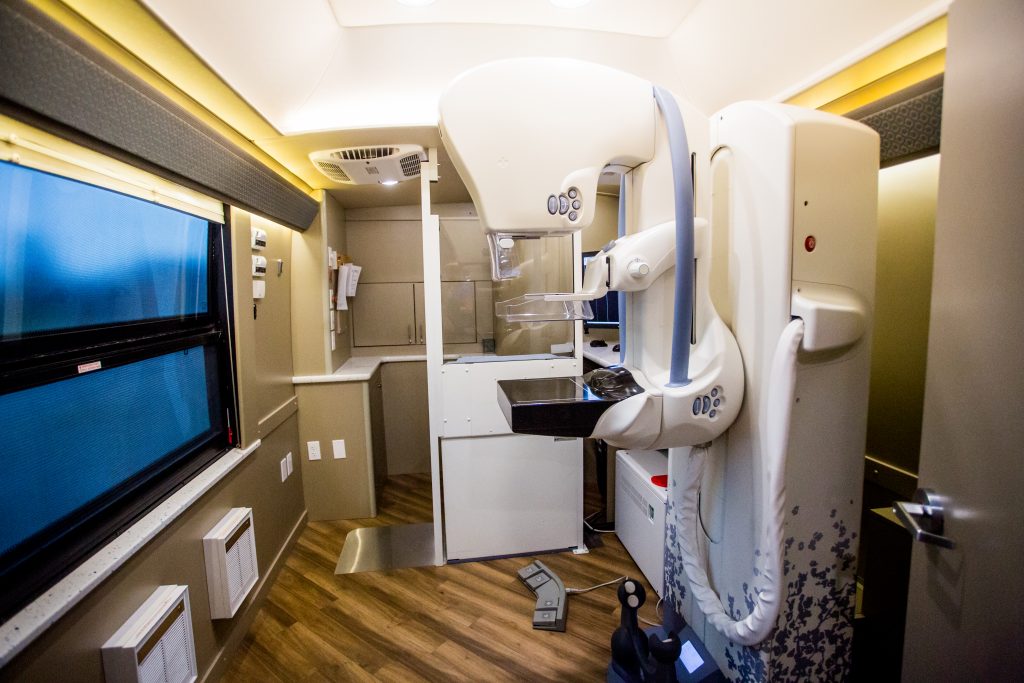Five Questions Patients Have About Breast Cancer Screening
by Caitlund Davidson
 The mammography unit used for breast screening on the Screen for Life Coach, one of six Ontario Breast Screening Program locations in Northwestern Ontario.
The mammography unit used for breast screening on the Screen for Life Coach, one of six Ontario Breast Screening Program locations in Northwestern Ontario.Originally published in the October 2024 edition of The Walleye Magazine
Medical tests like breast screening mammograms can often provoke feelings of fear and uncertainty in patients; whether it is the test itself or waiting for the results. Preventive tests like mammograms are important to find breast cancers when they are small, less likely to have spread and more likely to be treated successfully.
Dr. Nicole Zavagnin is the Regional Primary Care Lead for Ontario Health – Cancer Care Ontario at Thunder Bay Regional Health Sciences Centre (TBRHSC). In her practice, Dr. Zavagnin is a key source of information for her patients when it comes to breast screening and what to expect. Andrea Ruel, a Breast Patient Navigator at TBRHSC, helps patients who have been for breast screening mammograms get timely access to follow up tests if needed.
To help better understand the importance of breast screening, the process and to ease uncertainty, Dr. Zavagnin and Andrea, share some questions they get from patients before and after their mammograms.
If one of my family member has had breast cancer, does my chance of getting it increase?
NZ: Most breast cancers are not hereditary. Studies show that about five to ten percent of breast cancer cases are hereditary. If someone in your family has had breast cancer, your chances of getting those cancers may be higher. It is important to review your family history with a health care provider, so they can help determine your risk of cancer, and what type of screening is right for you.
Will the mammogram hurt?
NZ: While a mammogram might not be painful for everyone, it can be uncomfortable for some. The procedure involves compressing the breast between two plates to get clear images, which can create a feeling of pressure. If you find it uncomfortable, let the technologist know – they can often make adjustments to help minimize any discomfort. Overall, the benefits of screening usually outweigh the temporary discomfort.
Who will contact me if I need follow up tests?
AR: If you had your mammogram done at one of the Ontario Breast Screening Program (OBSP) sites in Northwestern Ontario and have an abnormal result, a Breast Patient Navigator will ensure that follow-up imaging is streamlined to ensure timely follow-up and diagnosis. Our Navigators work closely with screening staff, breast radiologists, and the regional OBSP sites to ensure coordination of care.
If I need further testing, does it mean I have cancer?
AR: It is important to note that further testing after an abnormal result does not necessarily mean that you have cancer. Follow up imaging may be required to better see details of the breast.
If I live in the region, where can I go for follow-up tests?
AR: Most follow-up tests are available at other regional hospitals or imaging sites across Northwestern Ontario. However, depending on the type of test, you may be asked to visit the Linda Buchan Centre at TBRHSC. If you have questions or concerns about breast screening, talk to your health care provider. To learn more about breast screening, eligibility and screening locations in Northwestern Ontario, visit tbrhsc.net/cancerscreening.